Brief Summary Of PLANET PLUTO
HEY GUYS, WELCOME TO OUR NEW BLOG :)
SO LETS, BEGIN✌
Pluto is the largest known dwarf planet in the Solar System, discovered in 1930. It was thought to be the 9th planet of our system for 75 years until the discovery of Eris and other similar objects that led to its demotion from a planet to a dwarf planet in 2006.
Key Facts & Summary
- It was the first Kuiper Belt object to be discovered and is the largest known plutoid. It was discovered in 1930 by Clyde Tombaugh and was classified for 75 years as the ninth planet of the Solar System.
- Since the beginning of the 1990s, its status as a planet was questioned following the discovery of other objects of similar size. After the discovery of Eris in 2005, Pluto was demoted in 2006 from a planet to a dwarf planet after the IAU defined the term “planet”.
- Pluto is the ninth-largest and tenth most massive known object directly orbiting the Sun. However, when it comes to the trans-Neptunian objects, it is the largest by volume but less massive than Eris.
- It is named after the Roman god of the underworld, the equivalent of Hades in Greek mythology.
- It is made primarily out of ice and rock. It is relatively small compared to Earth’s moon being about one-sixth of the moon’s mass, and one-third of its volume.
- Like other Kuiper Belt objects, it has an eccentric orbit. The eccentricity is moderate however and the orbit is inclined as it ranges from 30 AU to 49 AU.
- Due to its orbit, Pluto periodically comes closer to the Sun than Neptune. A stable orbital resonance with Neptune prevents them from colliding. The light from the Sun reaches Pluto in about 5.5 hours at its average distance of 39.5 AU.
- It has five moons: Charon, Styx, Nix, Kerberos and Hydra. Charon is the largest with a diameter just over half of Pluto. It is the biggest known moon of a dwarf planet.
- The relationship between Pluto and Charon is abstract. They are considered to have a binary system relation since the barycenter of their orbits, do not lie within either body.
- One day on Pluto lasts about 153 hours while a whole trip around the Sun is completed in about 248 years. Its moon Charon also orbits Pluto in about 153 hours never rising or setting, hovering around the same spot facing Pluto with only one side, a state called tidal locking.
- It has a radius of 737 miles or 1,185 kilometers thus it is about 1/6 the width of Earth, and a diameter of 1,445 miles or 2,326 kilometers.
- It has a surface characterized of mountains, valleys and craters. The temperature varies from -375 to -400 degrees Fahrenheit or -226 to -240 degrees Celsius.
Through the use of Newtonian mechanics in 1840 by Urbain Le Verrier, it was discovered that there were perturbations in Uranus’s orbit. After Neptune was discovered and its mass calculated, it was speculated that a larger object was needed to explain this, thus the hypothesis of Planet X was born. In 1894 Percival Lowell, a businessman and astronomer founded the Lowell Observatory and in 1906 he commenced the search for Planet X for nearly a decade until Lowell passed away in 1916.
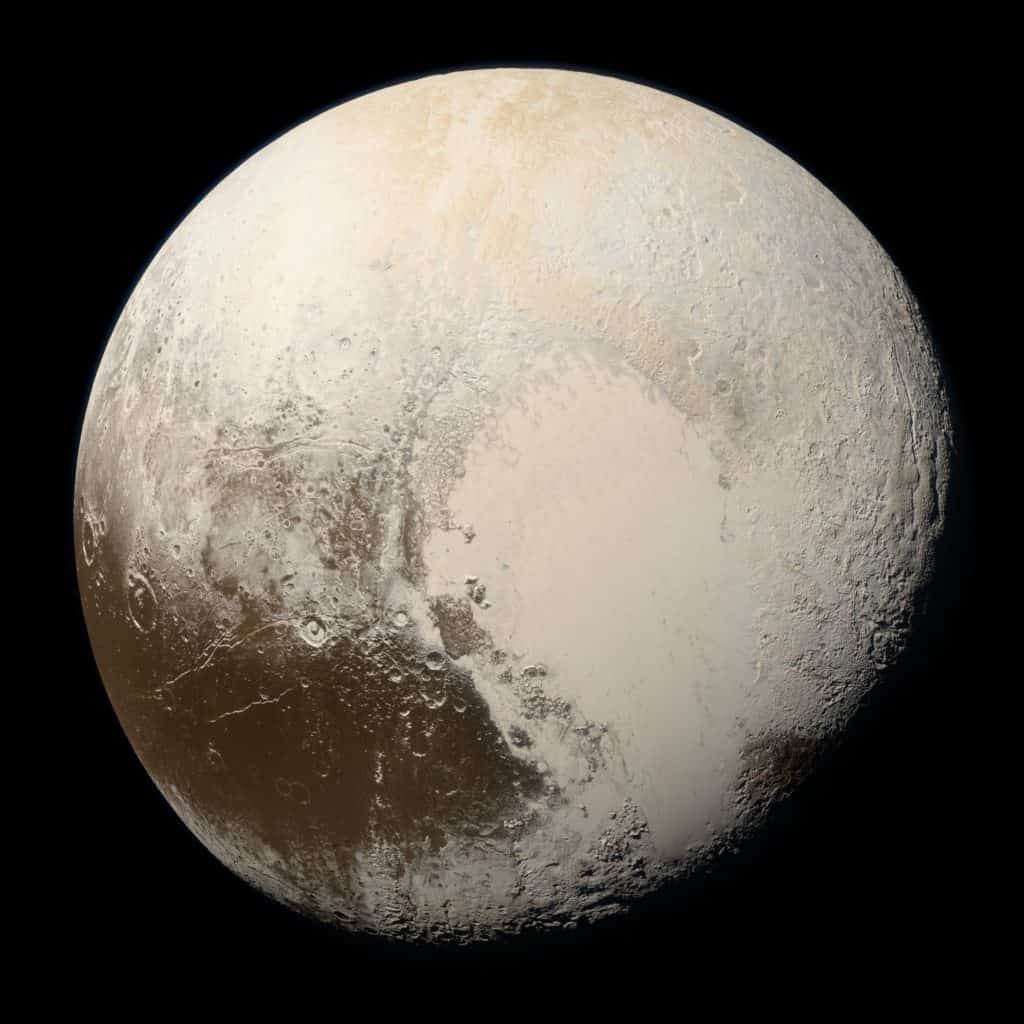
Unknown to Lowell, his surveys had captured two faint images of Pluto, but they were not recognized for what they were. The search for Planet X resumed in 1929 after his widow fought for his legacy and the search continued.
The observatory director gave the task of finding Planet X to a 23 year old named Clyde Tombaugh who after one year of hard work had finally found it. The news made headlines everywhere, and the Lowell Observatory thus gained the right to name the new discovery.
The name Pluto was proposed by Venetia Burney, an eleven schoolgirl in Oxford, England, after a survey was conducted, and the name Pluto won by votes. The name was announced on May 1, 1930. The then little girl received a modern equivalent of 450 USD. The final choice of a name was helped in part by the fact that the first letters of Pluto are the initials of Percival Lowell.
Classification controversy
Pluto’s demotion as a planet to a dwarf planet is still highly controversial to this day. Even now there are people in high positions at NASA who vehemently opt for Pluto’s reclassification as a planet while others still consider it as a planet regardless of IAU’s decision.
NASA’s Administrator Jim Bridenstine, publicly declared that Pluto should definitely be a planet. Observations from NASA’s New Horizons spacecraft in 2015 revealed a greater complexity of Pluto than previously believed. A probable underground ocean, organic materials (the potential precursors of life) on the surface, and a multilayered atmosphere were revealed and thus prompt new debates around Pluto. Pluto was classified as a planet for 75 years and later demoted to the status of a dwarf planet after similar objects were discovered in the Kuiper Belt. However, the discovery of Eris in 2005, a dwarf planet similar to Pluto, caused problems to erupt and thus triggered the debate in the scientific community about what should be considered a planet. Three requirements were stated:
The object must be in orbit around the Sun
The object must be massive enough to be rounded by its own gravity.
It must have cleared the neighborhood around its orbit.
Pluto failed to meet the third condition. Its mass is substantially less than the combined mass of the other objects in its orbit 0.07 times, in contrast to Earth, which is 1.7 million times the remaining mass in the orbit, without the moon.
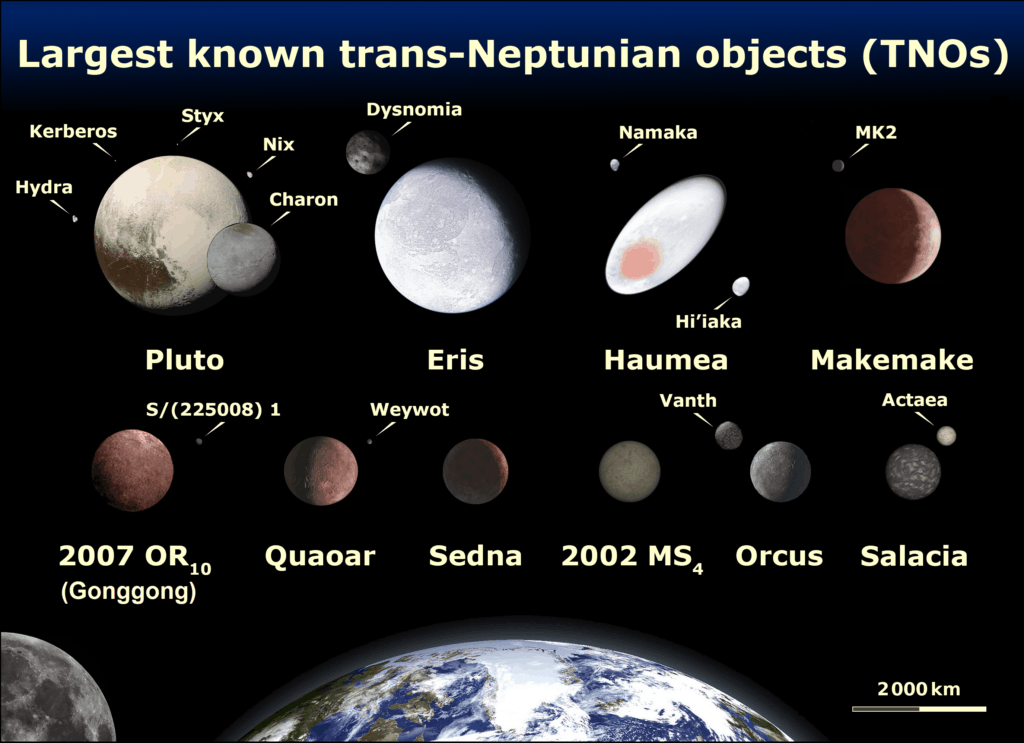
Regardless, the debate is still ongoing. In 2006 the American Dialect Society voted plutoed, as the word of the year. To “pluto” is to “demote or devalue someone or something.” Even so, Pluto gained some valor as the term “plutoid” would be used to refer to both it and other objects that have an orbital semi-major axis greater than that of Neptune and enough mass to be of near-spherical shape.
Formation
Pluto is the largest member of a group of objects that orbit in a disc-like zone beyond the orbit of Neptune, called the Kuiper Belt. This far away realm is populated with thousands of miniature icy worlds, which formed early in the history of our Solar System about 4.5 billion years ago. The origin and identity of Pluto has long puzzled astronomers.
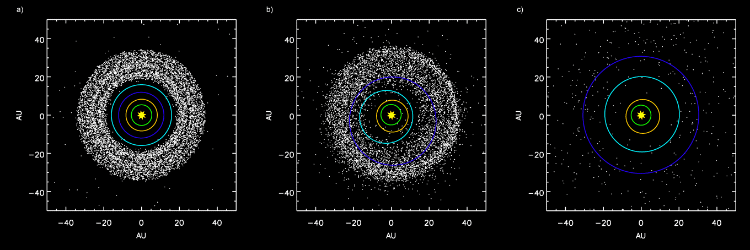
Pluto shares feature with comets, like the solar wind that is gradually blowing Pluto’s surface into space. It has been theorized that Pluto may have formed as a result of the conglomeration of numerous comets and related Kuiper belt objects. Though Pluto is the largest known Kuiper belt object, Neptune’s moon Triton is slightly larger, has similar geology and atmosphere, and it is thought to have been a captured Kuiper belt object. Eris is about the same size as Pluto, but not a permanent member of the Kuiper belt, since it also reaches a linked population called the scattered disc. Kuiper belt objects:
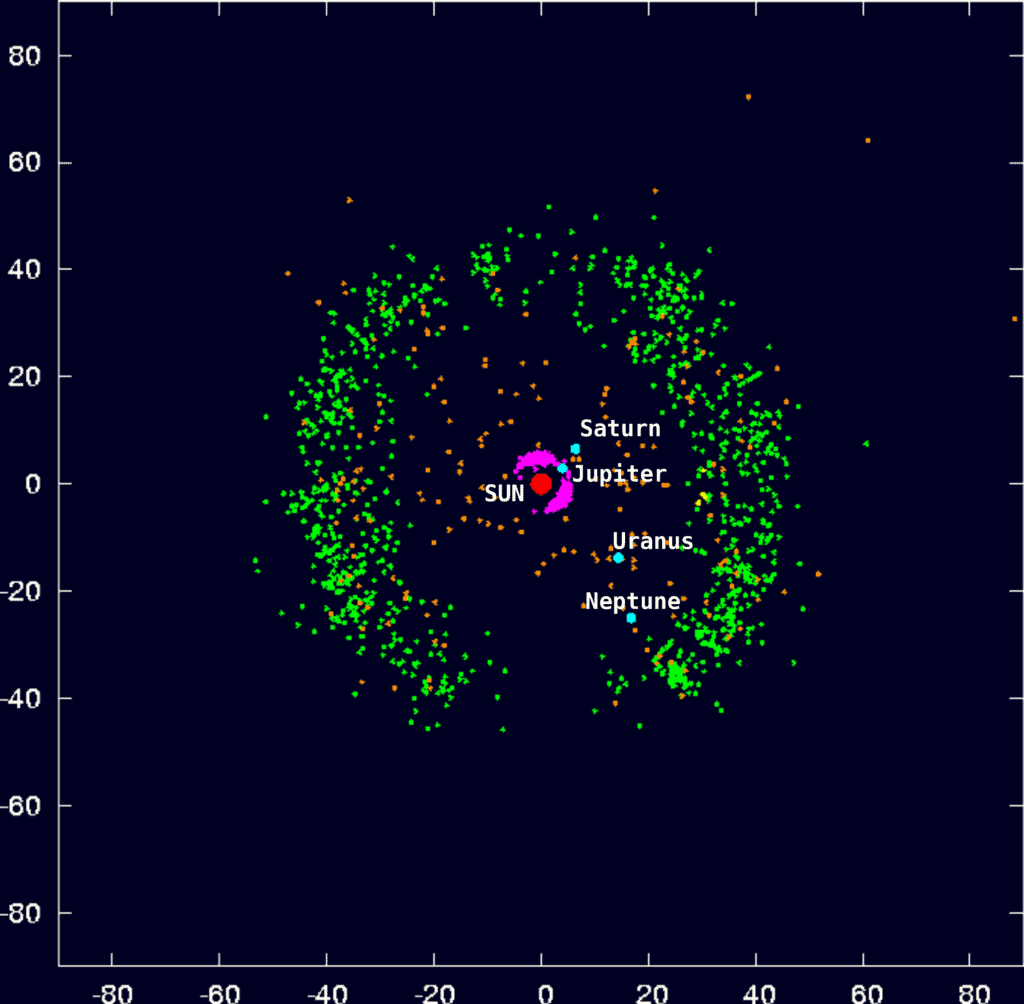
Many Kuiper belt objects have a 2:3 orbital resonance with Neptune and are called plutinos. They are thought to be residual from a body which could come together with many others to form a planet but they failed to fully coalesce into a full-fledged planet. It is believed that Pluto owes its current position to a sudden migration undergone by Neptune early in the Solar System’s formation. The Nice model requires that there were about a thousand Pluto-sized bodies in the original planetesimal disk, which included Triton and Eris.
Distance, Size and Mass
Due to its orbit, Pluto periodically comes closer to the Sun than Neptune. A stable orbital resonance with Neptune prevents them from colliding. The light from the Sun reaches Pluto in about 5.5 hours at its average distance of 39.5 AU. In its furthest point, Pluto is 48.9 AU distance from the sun, at its closest it is 29.7 AU. Currently Pluto is 34.3 AU distance from the Earth, light takes about 4 hours and 45 minutes to travel from it to us.
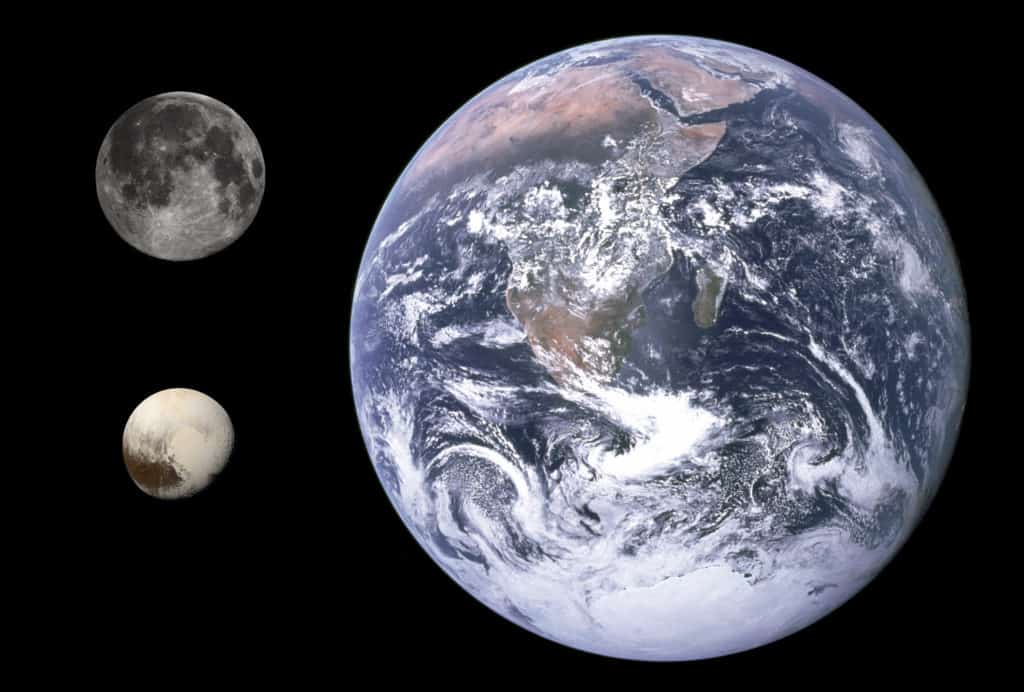
The surface area of Pluto is a bit bigger than Russia, and it is about half as wide as the United States, with a gravity of 0.063 g, Earth has 1 g. It has a diameter of 2,376 kilometers or 1476 miles and a radius of 1,188 kilometers or 738 miles. It is about 1/6 the size of Earth or 18%, and it has 70% the diameter of Earth’s moon.
The mass of Pluto is 1.3 x 1022 kg, which is only 0.22% that of Earth or 18% that of Earth’s moon. The mass of Pluto is also smaller than six other moons: Titan, Callisto, Io, Ganymede, Europa and Triton. Pluto is more than twice the diameter and a dozen times the mass of the dwarf planet Ceres, the largest object in the asteroid belt. It is less massive than the dwarf planet Eris.
Orbit and Rotation
One day on Pluto lasts about 153 hours while a whole trip around the Sun is completed in about 248 years. It has an unusual orbit, both elliptical and tilted. Its oval-shaped orbit can take it 48.9 AU away from the Sun and 29.7 AU at its closest but on average it is about 39 AU.

Even if it appears that Pluto will collide with Neptune, their orbits are aligned so that they can never do this or even approach each other closely. Pluto’s rotation period, a day, is equal to 6.39 Earth days. Like Uranus and Venus, it exhibits a retrograde rotation, spinning from East to West. Pluto rotates on its “side” in its orbital plane, with an axial tilt of 120°, and so its seasonal variation is extreme. At its solstice, one-fourth of the surface is in continuous daylight, another fourth in complete darkness.
Geology, Structure and Atmosphere
The surface of Pluto is composed mostly of about 98% nitrogen ice, with traces of methane and carbon monoxide. Nitrogen and carbon monoxide are most abundant on the anti-Charon face where Tombaugh Regio’s western lobe, Sputnik Planitia is located. It has mountains covered in water ice.
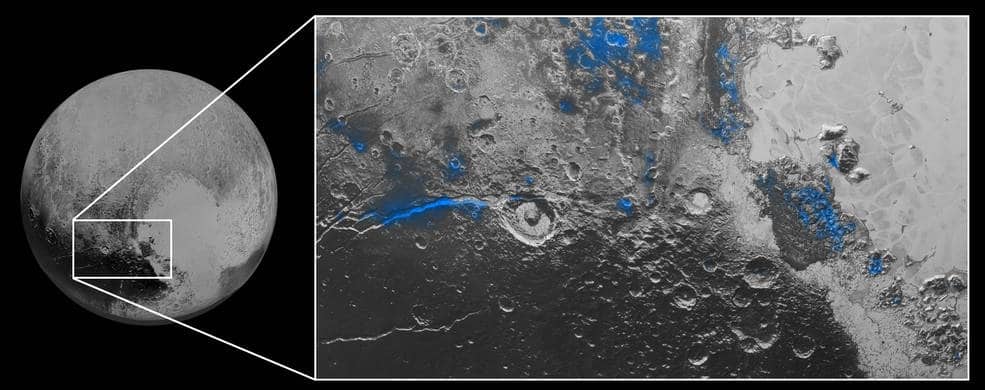
Pluto’s surface is quite varied, with large differences in both brightness and color. It is one of the most contrastive bodies in the Solar System, similar in contrast with Saturn’s moon Iapetus. The color varies from charcoal black, dark orange and white. It is similar in color with Io, but with a little more orange, and it has significantly less portions of red than Mars.
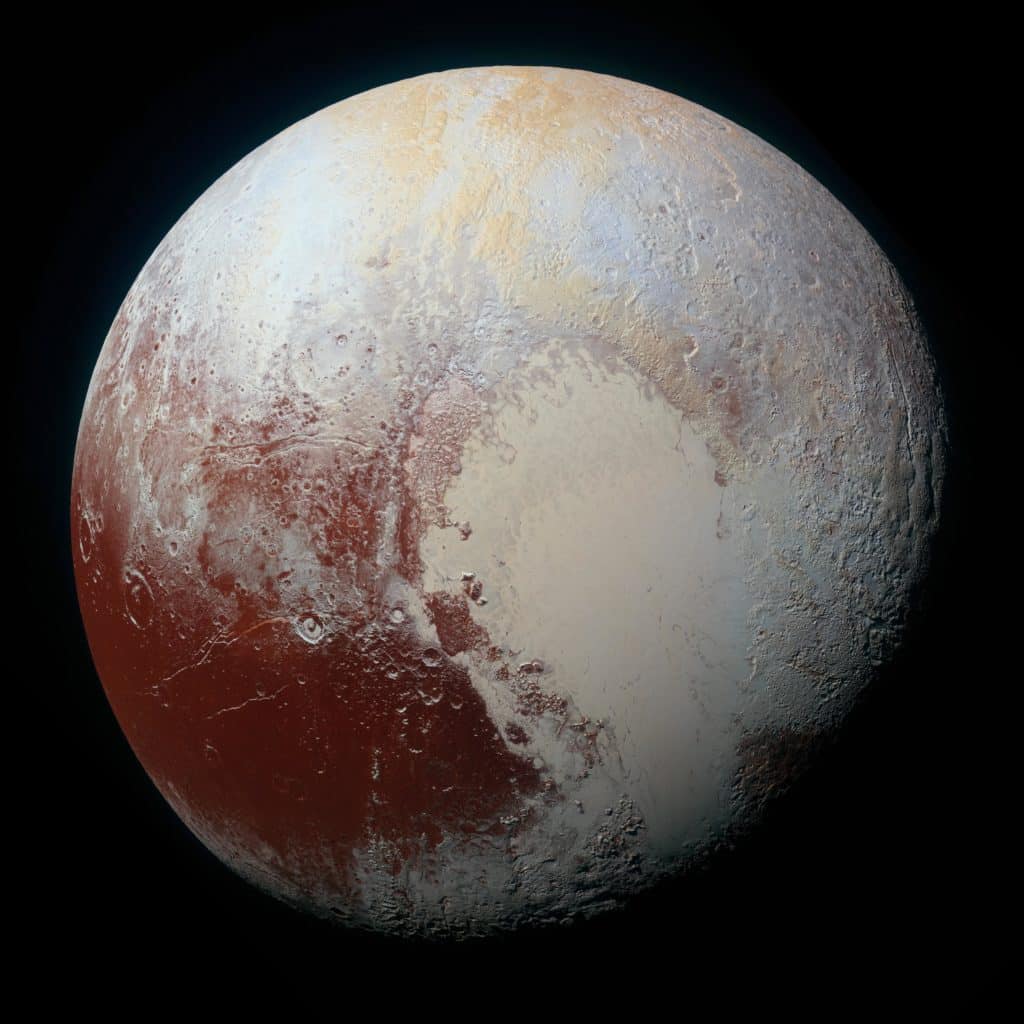
Notable geographical regions include Tombaugh Regio, or the “Heart”, a large bright area on the side opposite its moon Charon, Cthulhu Macula, or the “Whale”, a large dark area on the trailing hemisphere, and “Brass Knuckles”, a series of equatorial dark areas on the leading hemisphere. Sputnik Planitia, the western lobe of the “Heart”, is a 1,000 kilometer or 621 miles wide basin of frozen nitrogen and carbon monoxide ices. There are clear signs of glacial flows both into and out of the basin. Yet it does not have any craters, suggesting that its surface is less than 10 million years old.
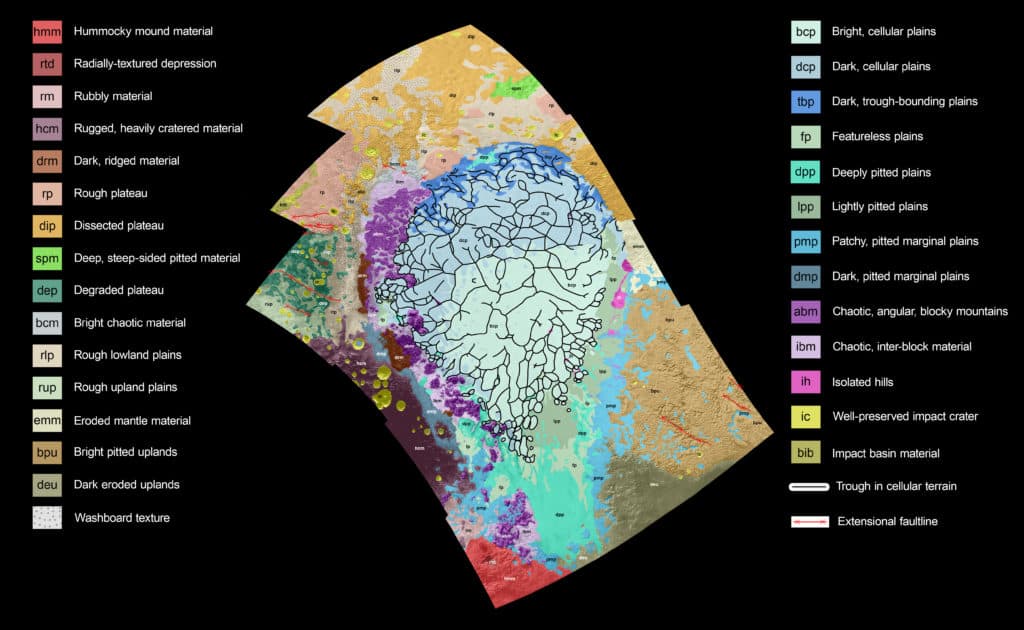
Pluto’s density is 1.860±0.013 g/cm3 and has no magnetic field. Since the decay of radioactive elements would eventually heat the ices enough for the rock to separate from them, scientists expect that Pluto’s internal structure is differentiated, with the rocky material having settled into a dense core surrounded by a mantle of water ice.
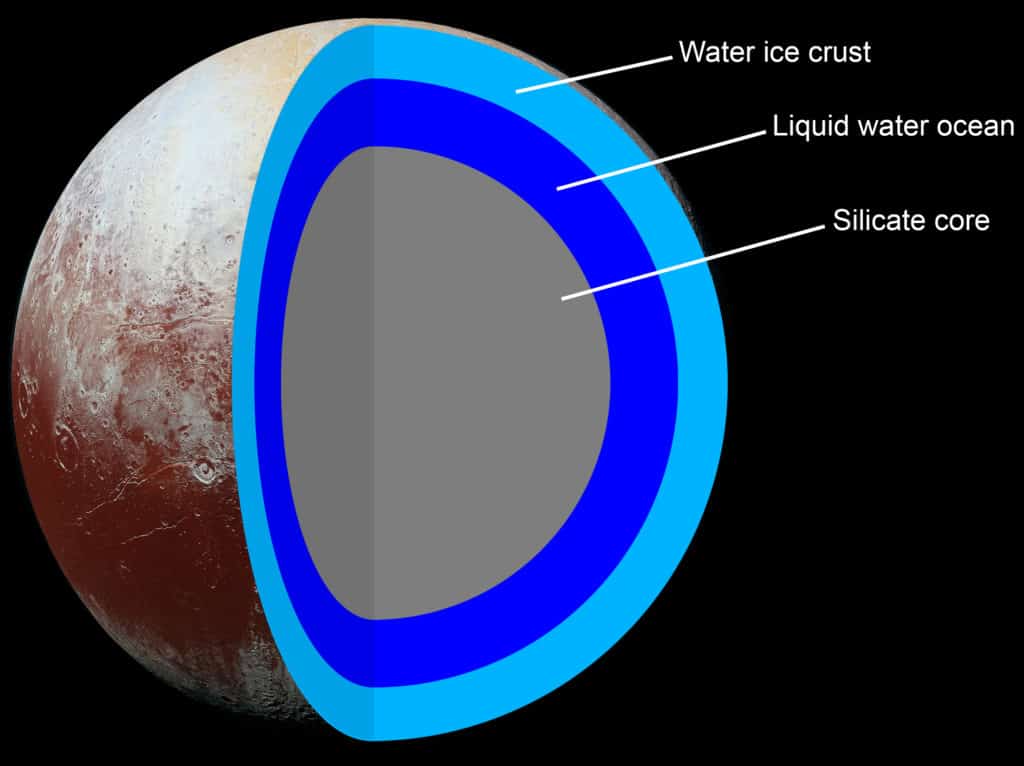
It is hypothesized that the diameter of its core would be around 1700 kilometers or 1,056 miles, almost 70% of Pluto’s diameter.
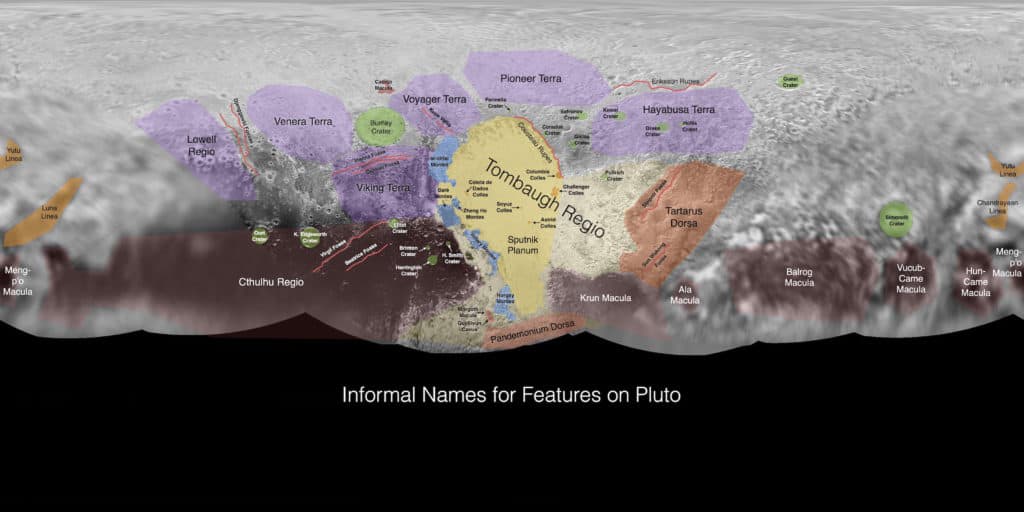
The atmosphere of Pluto is similar to that of a comet. It has a thin, tenuous atmosphere that expands when it comes closer to the sun and collapses as it moves further away. When it approaches the sun, its surface ices sublimate, changing from solid to gas, and rises to temporarily form a thin atmosphere. New results indicate that it likely remains gaseous. The presence of atmospheric gases was traced up to 1670 kilometers high or 1037 miles, and does not have a sharp upper boundary.
The tenuous atmosphere is consisting of nitrogen, methane, and carbon monoxide. According to measurements by New Horizons, the surface pressure is about 1 Pa, roughly one million to 100,000 times less than Earth’s atmospheric pressure.
Through observations by New Horizons, it has been revealed that Pluto’s upper atmosphere to be far colder than expected, 70K or -203.15 degrees Celsius. The atmosphere is divided into about 20 regularly spaced haze layers up to 150 kilometers high, or about 93 miles.
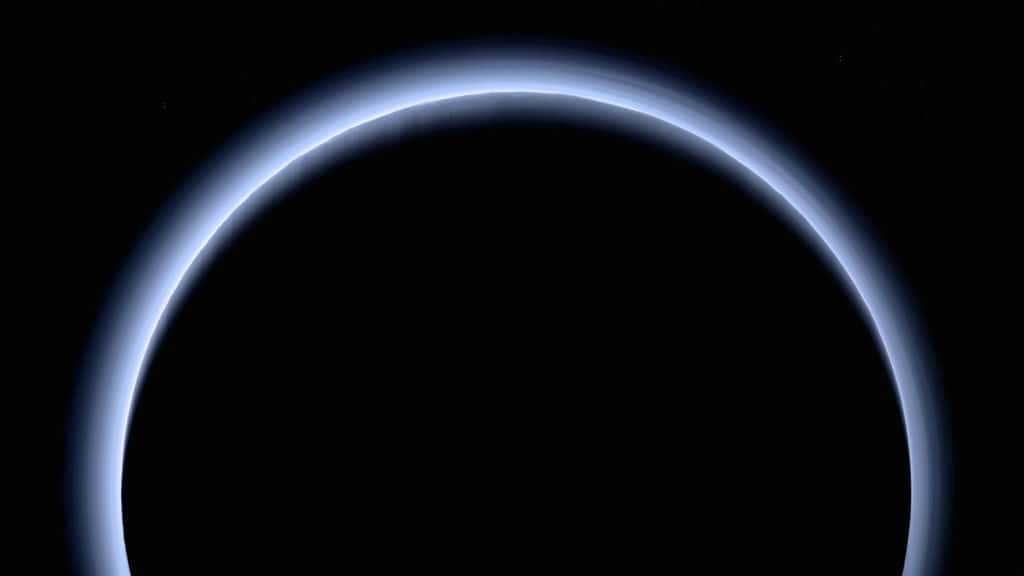
Moons
Only five natural satellites have been discovered orbiting Pluto. It is believed that this moon system was formed after a collision with a body similar in size to Pluto, in the early history of the solar system.

Charon is the biggest moon of Pluto, followed by four much smaller circumbinary moons: Nix, Styx, Kerberos and Hydra. They were first identified in 1978 by astronomer James Christy. The orbit periods of all the moons are linked in a system of orbital resonances and near resonances. The 4 small moons spin and don’t keep the same face towards Pluto, as Charon does.
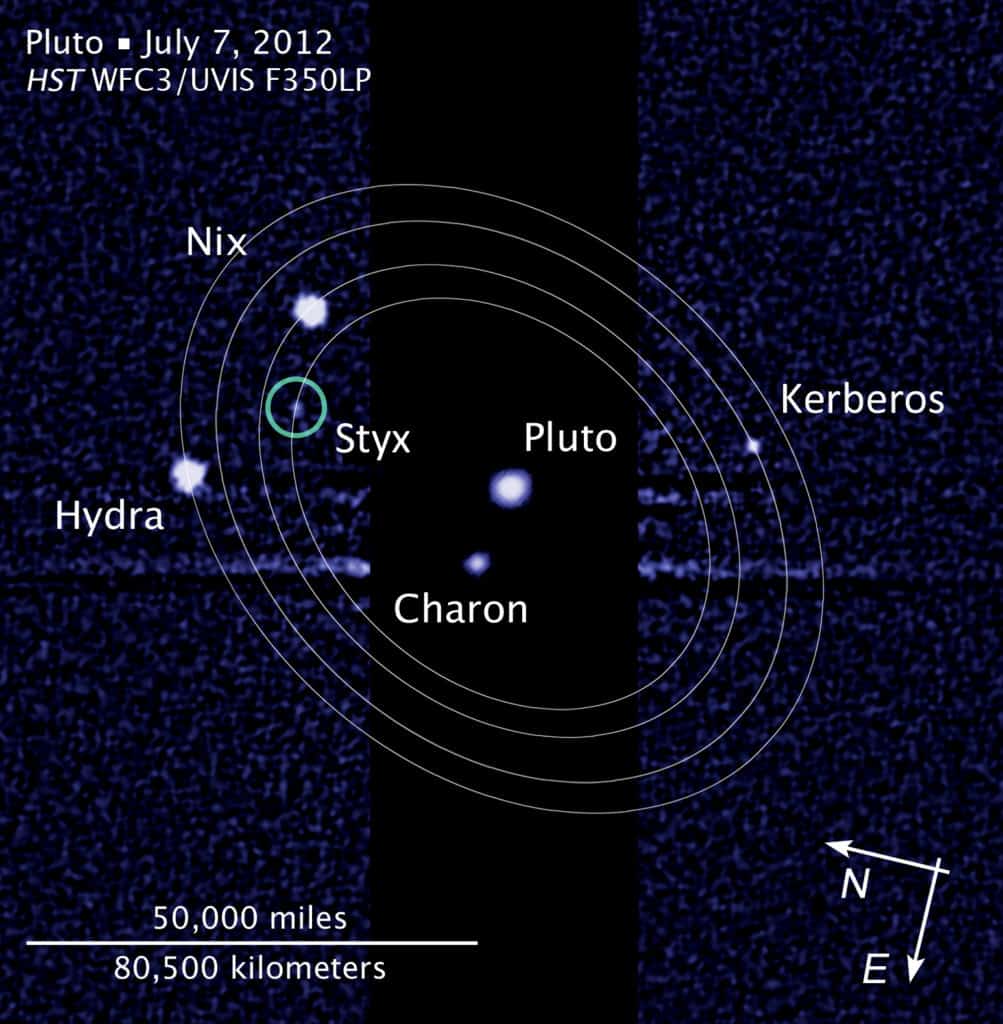
Charon
It is named after the ferryman of the dead in Greek mythology. It is Pluto’s largest moon with a mean radius of 606 kilometers or 377 miles. It has about half the diameter of Pluto and also one-eight of its mass, being the biggest known moon of a dwarf planet. Due to its size the gravitational influence is such that the barycenter or the plutonian system lays outside Pluto the same as in the case of the Sun and Jupiter. Some prefer to think of Pluto/Charon as a double planet rather than a planet and a moon.
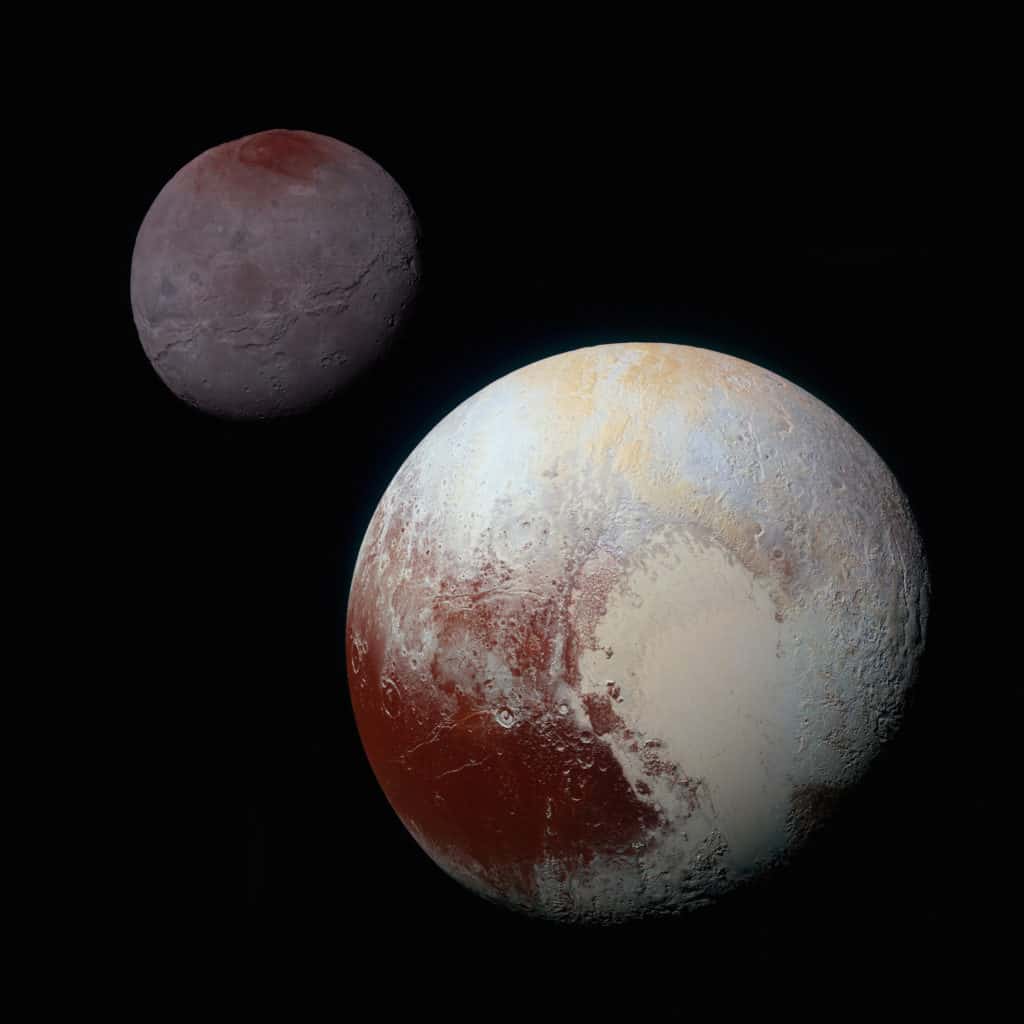
Charon and Pluto orbit each other once every 6.387 days. They are gravitationally locked to one another. Each keeps the same face towards the other. It is 55% composed out of rock and 45% out of ice. It doesn’t have an atmosphere and its reddish polar region, informally dubbed Mordor, is the result of the presence of tholins – organic molecules based on methane and nitrogen. These molecules are not believed to be native to Charon but rather originated on Pluto and were carried over somehow. Crossing its equator, a massive belt of possible tectonic fracturing indicates that something tried to tear Charon apart.
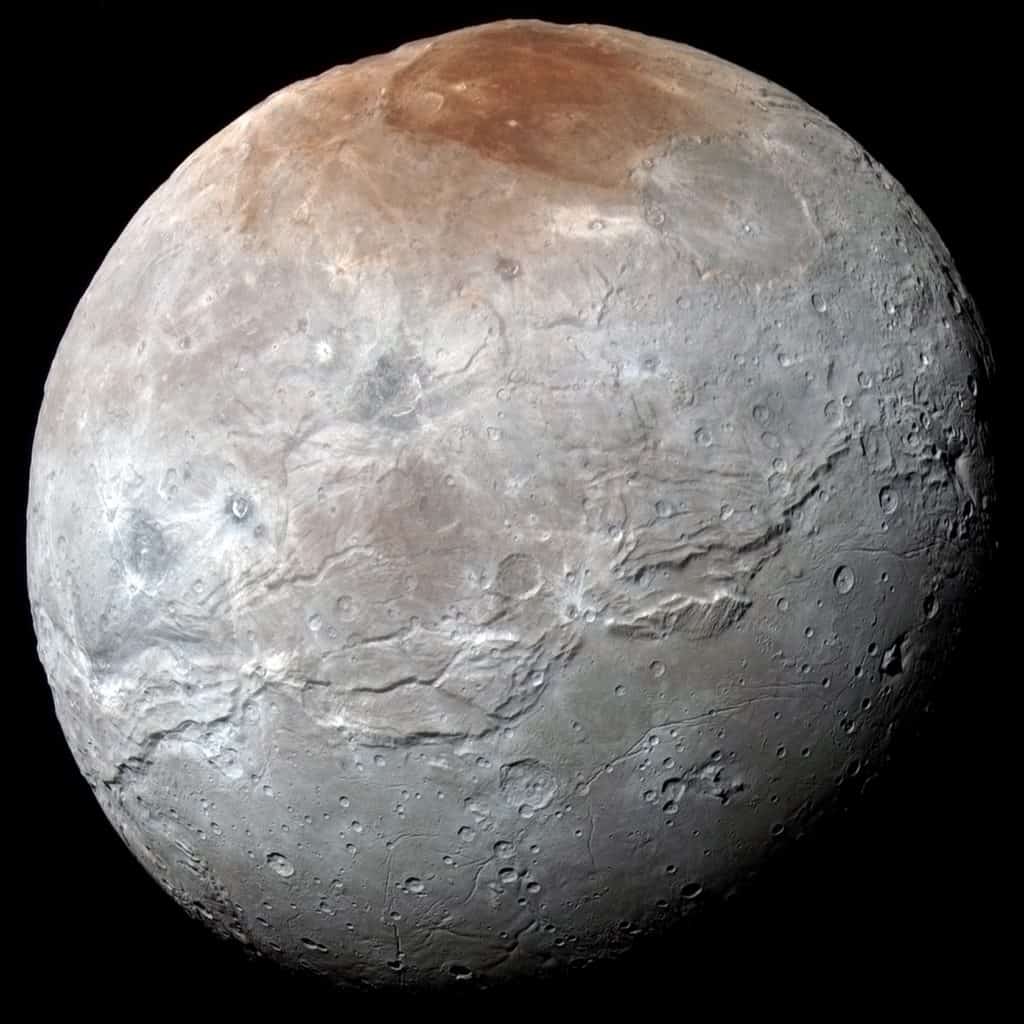
It is believed that Charon was formed after Pluto suffered a collision with a similar body. The other theory is that Charon collided with Pluto and thus resulted in its current stage.
Nix
It has a diameter of 49.8 kilometers or 30.9 miles and was discovered along with Hydra in June 2005. It was named after the Greek goddess of the night. It is the third moon of Pluto by distance, orbiting between the moons Styx and Kerberos. The reason for naming it Nix, and the other moon Hydra, was to honor the spacecraft mission New Horizons, the initials N and H.
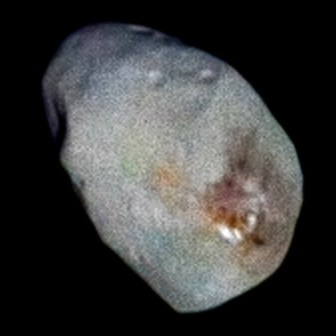
The reddish area on Nix is most likely due to an impact crater. Nix’s brightness is about 5,000 fainter than Pluto’s. It is thought to have been formed from debris after Pluto suffered a collision. It is not tidally locked and tumbles chaotically similar to the other small moons. It completes a rotation in 43.9 hours retrograde to Pluto’s equator with an axial tilt of 132 degrees. The rotation rate has increased since it was estimated, by about 10%.
Nix orbits the Pluto-Charon barycenter at a distance of 48.694 kilometers of 30,257 miles, between the orbits of Styx and Kerberos. All of Pluto’s moons have very circular orbits that are coplanar to Charon’s orbit. Nix has an orbital period of approximately 24.8546 days and its orbit is resonant with other moons of Pluto. Nix is in a 3:2 orbital resonance with Hydra, and a 9:11 resonance with Styx.
Styx
Styx’s discovery was announced in 2012, it is the second satellite of Pluto by distance and the last discovered, one year after Kerberos. It is approximately 16 kilometers or 9.9 miles across its longest dimension with an orbital period of 20.2 days.
It orbits the Pluto-Charon barycenter at a distance of 42,656 kilometers, putting it between the orbits of Charon and Nix. It is in an 11:6 orbital resonance with Hydra, and an 11:9 resonance with Nix. Styx was both a deity and a river that formed the boundary between Earth and the Underworld in Greek mythology.
Kerberos
Kerberos is about 19 kilometers or 12 miles in its longest dimension. It was the fourth moon to be discovered, and was announced in 2011. The double-lobed shape of Kerberos is likely formed by two smaller objects that merged.
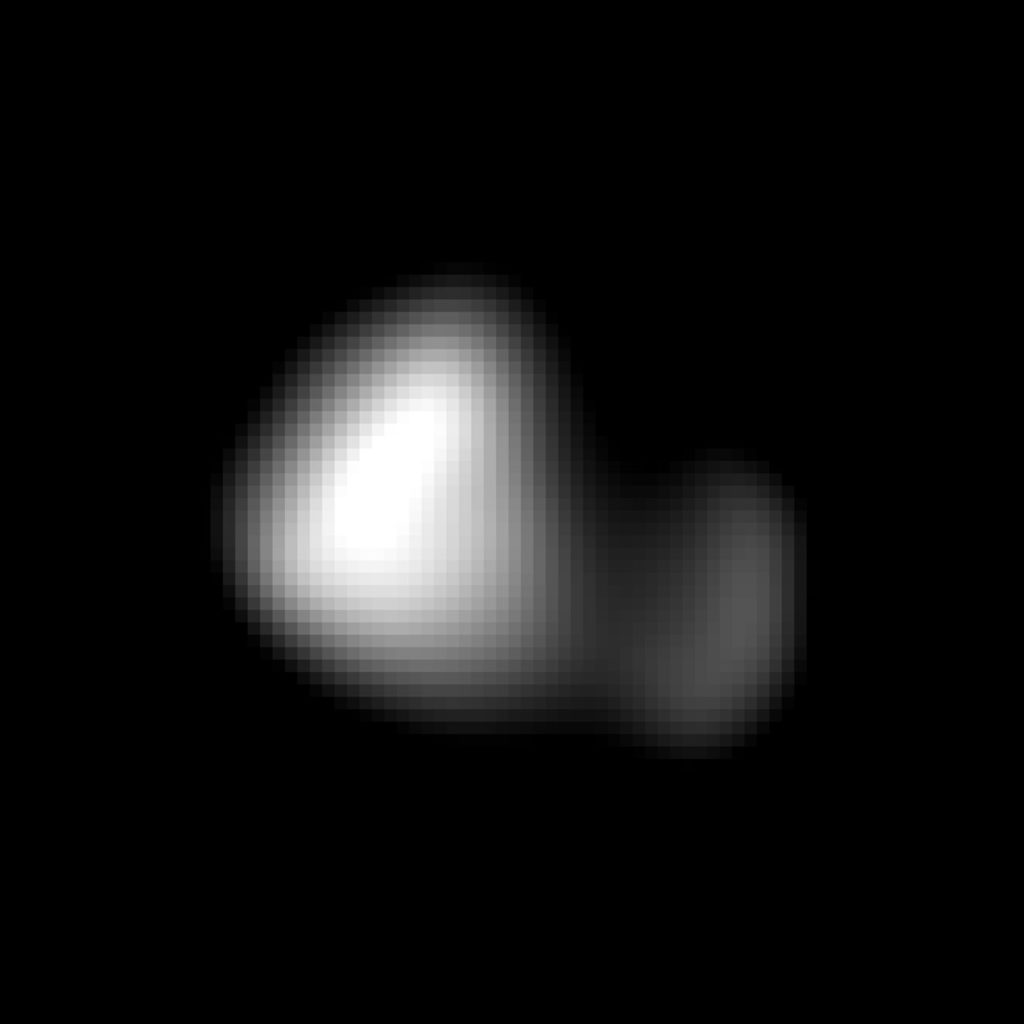
Like the other small moons it has a chaotic rotation. At the time of the New Horizons flyby, the rotational period of Kerberos was about 5.33 days and its rotational axis was tilted about 96 degrees to its orbit. It orbits the Pluto-Charon barycenter at a distance of 57,783 kilometers or 35,905 miles. It orbits between Nix and Hydra and makes a complete orbit around Pluto roughly every 32.127 days. It was supposed to be called Cerberus but the name was taken, thus the Greek form of the name Kerberos was acceptable to the IAU. Cerberus in Greek mythology was a multi-headed dog that guarded the gates of the underworld.
Hydra
It is the second largest moon of Pluto, with a diameter of about 51 kilometers or 32 miles, slightly bigger than Nix. They were both discovered in 2005. It was named after the nine-headed underworld serpent in Greek mythology.

By distance, it is the fifth and outermost moon of Pluto, orbiting beyond Pluto’s fourth moon Kerberos. It has a highly reflective surface caused by the presence of water ice, similar to other plutonian moons.
Hydra is about 5.000 times fainter than Pluto. The water ice on Hydra’s surface is relatively pure and shows no significant darkening compared to Charon. The surface spectrum of Hydra is slightly bluish compared to that of Nix. At the time of the New Horizons flyby of Pluto and its moons, Hydra’s rotation period was approximately 10 hours and its rotational axis was tilted about 110 degrees to its orbit. Hydra is the only plutonian moon that completes a rotation in less than a day, making it the fastest.
Hydra orbits the Pluto-Charon barycenter at a distance of 64,738 kilometers or 40,226 miles. Hydra has an orbital period of approximately 38.2 days and is resonant with other moons of Pluto. Hydra is in a 2:3 orbital resonance with Nix, and a 6:11 resonance with Styx.
Life Habitability
Due to extreme cold temperatures, it seems unlikely that life could exist there. Even if water is present, it is essentially rock-like.
Future plans for Pluto
NASA’s New Horizons probe reached Pluto in 2015, but it zoomed past the dwarf planet in a matter of minutes because of its tremendous velocity. Now, the agency is considering the possibility of sending another mission to Pluto, but this one would stay in orbit to study the surface. Since the last mission was a success, revealing a complex world, it is only natural that further expeditions would be sent there.
Did you know?
- The discoverer of Pluto, Clyde W. Tombaugh, had his ashes placed aboard the New Horizons spacecraft.
- It was closer to the Sun than Neptune since 1979 until 1999.
- It has yet to complete a full orbit around the Sun since its discovery because one Plutonian year is 247.68 years long.
- After Pluto was named, in 1941 Glenn T. Seaborg named a new element, plutonium after Pluto, uranium after Uranus and neptunium after Neptune, following the tradition of naming an element after a new planet was discovered.
- Walt Disney named a canine companion of Mikey Mouse, Pluto.
- Most languages use the name “Pluto” in various transliterations. In Japan it is known as Meiosei – Star of the King (God) of the Underworld, in Hindi it is known as Yama, the God of Death in Hindu and Buddhist mythology.
- Pluto’s moon Charon is bigger than the dwarf planet Eris.
- Pluto is the second closest dwarf planet to the sun, first place is held by Eris.
- Pluto is one third made out of water.
- The distance between Pluto and Charon is about the same as from one side of South America to the last side of North America.
Bibliography:
- Hamilton, Calvin J. (February 12, 2006). “Dwarf Planet Pluto”. Views of the Solar System.
- The Inside Story”. pluto.jhuapl.edu – NASA New Horizons mission site. Johns Hopkins University Applied Physics Laboratory. 2007. Archived from the original on May 16, 2008.
- Trowbridge, A. J.; Melosh, H. J.; Steckloff, J. K.; Freed, A. M. (June 1, 2016). “Vigorous convection as the explanation for Pluto’s polygonal terrain”. Nature. 534 (7605): 79–81.
- McKinnon, W. B.; Nimmo, F.; Wong, T.; Schenk, P. M.; White, O. L.; et al. (June 1, 2016). “Convection in a volatile nitrogen-ice-rich layer drives Pluto’s geological vigour”. Nature. 534(7605): 82–85.
- Buie, Marc W.; Grundy, William M.; Young, Eliot F.; et al. (2010). “Pluto and Charon with the Hubble Space Telescope: II. Resolving changes on Pluto’s surface and a map for Charon”. Astronomical Journal. 139 (3): 1128–1143
- NASA (September 14, 2016). “X-ray Detection Sheds New Light on Pluto”. nasa.gov. Retrieved December 3, 2016.
- Porter, Simon B.; et al. (2016). “The First High-phase Observations of a KBO: New Horizons Imaging of (15810) 1994 JR1 from the Kuiper Belt”. The Astrophysical Journal Letters. 828 (2)
- Going Back to Pluto? Scientists to Push for Orbiter Mission”. Space.com.
Image source:
- https://upload.wikimedia.org/wikipedia/commons/e/ef/Pluto_in_True_Color_-_High-Res.jpg
- https://upload.wikimedia.org/wikipedia/commons/9/91/EightTNOs.png
- https://en.wikipedia.org/wiki/Nice_model#/media/File:Lhborbits.png
- https://upload.wikimedia.org/wikipedia/commons/8/81/Outersolarsystem_objectpositions_labels_comp.png
- https://upload.wikimedia.org/wikipedia/commons/9/91/Pluto%2C_Earth_%26_Moon_size_comparison.jpg
- https://upload.wikimedia.org/wikipedia/commons/thumb/a/a0/TheKuiperBelt_Orbits_Pluto_Polar.svg/400px-TheKuiperBelt_Orbits_Pluto_Polar.svg.png
- https://upload.wikimedia.org/wikipedia/commons/6/60/NH-Pluto-WaterIceDetected-BlueRegions-Released-20151008.jpg
- https://upload.wikimedia.org/wikipedia/commons/a/a7/Pluto-01_Stern_03_Pluto_Color_TXT.jpg
- https://upload.wikimedia.org/wikipedia/commons/e/ef/Pluto%27s_Sputnik_Planum_geologic_map_%28cropped%29.jpg
- https://upload.wikimedia.org/wikipedia/commons/a/a5/Pluto%27s_internal_structure2.jpg
- https://upload.wikimedia.org/wikipedia/commons/b/b9/Pluto-Map-Annotated.jpg
- https://upload.wikimedia.org/wikipedia/commons/5/5d/PIA21590_%E2%80%93_Blue_Rays%2C_New_Horizons%27_High-Res_Farewell_to_Pluto.jpg
- https://upload.wikimedia.org/wikipedia/commons/c/c7/Nh-pluto_moons_family_portrait.png
- https://upload.wikimedia.org/wikipedia/commons/1/1a/Pluto_moon_P5_discovery_with_moons%27_orbits.jpg
- https://upload.wikimedia.org/wikipedia/commons/2/23/Pluto-Charon-v2-10-1-15.jpg
- https://upload.wikimedia.org/wikipedia/commons/0/01/Charon-Neutral-Bright-Release.jpg
- https://upload.wikimedia.org/wikipedia/commons/5/51/Nix_best_view.jpg
- https://upload.wikimedia.org/wikipedia/commons/2/23/Kerberos_%28moon%29.jpg
- https://upload.wikimedia.org/wikipedia/commons/f/f6/Hydra_Enhanced_Color.jpg
THANKS FOR READING👍
Water Hack Burns 2lb of Fat OVERNIGHT
ReplyDeleteOver 160,000 women and men are utilizing a easy and SECRET "liquid hack" to drop 2 lbs each and every night in their sleep.
It's very easy and it works all the time.
Here are the easy steps for this hack:
1) Take a drinking glass and fill it half glass
2) And now use this amazing hack
and you'll be 2 lbs skinnier when you wake up!